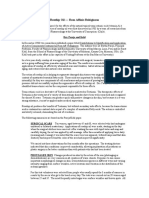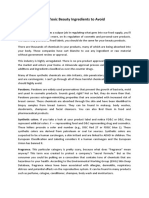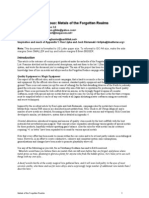History of Toothpaste
History of Toothpaste
Uploaded by
E. SubinCopyright:
Available Formats
History of Toothpaste
History of Toothpaste
Uploaded by
E. SubinCopyright
Available Formats
Share this document
Did you find this document useful?
Is this content inappropriate?
Copyright:
Available Formats
History of Toothpaste
History of Toothpaste
Uploaded by
E. SubinCopyright:
Available Formats
History of Toothpaste
Although toothpaste was used as long ago as 500 BC in ancient Egypt, China and India, it was not until the 19th century that toothpastes came into general use. Ancient tooth powders used abrasive ingredients such as crushed bone, burned and crushed egg, snail or oyster shells, which were used to clean debris from teeth. First 'modern' toothpastes in the 1800s were home made, with chalk, soap and salt as common ingredients and were sold in jars either as a powder or paste. A dentist in US was the man who invented tooth paste tube, in 1892. The most important breakthrough in the history of toothpaste was the addition of fluoride in a toothpaste in 1914. Fluoride use in toothpastes became widespread much later in the 1950's.
Toothpaste Ingredients
A modern toothpaste has much more ingredients than those some years ago. New toothpaste ingredients have been introduced in order to provide effective protection against various dental conditions. The most common active ingredients in toothpastes are : Fluoride is the most popular active ingredient in toothpaste due to its proved ability to prevent cavities. Most toothpaste brands use Sodium fluoride (NaF); some brands use Sodium Monofluorophosphate - SMFP(Na2PO3F). The concentration of fluoride in a toothpaste for adults is 1000 to 1450 ppm max. Antimicrobial agents that fight the bacteria of dental plaque. There are two kinds of antibacterial agents used as ingredients of toothpastes : - bactericidal agents as Triclosan that kill bacteria. Triclosan induces damage and lesions to the cell wall of bacteria resulting in bacteriolysis (death of the cell). - bacteriostatic agents as Zinc (Zinc chloride or Zinc citrate) that stop the growth of dental plaque bacteria by inhibiting their metabolism. The combination of a bacteriostatic with a bactericidal agent as toothpaste ingredients is the most effective one to fight dental plaque and gum disease. Surfactants (detergents) and Foaming agents that help to carry away debris from the mouth and between the teeth. Common foaming ingredients in toothpastes are Sodium Lauryl Sulfate (SLS) and ammonium lauryl sulfate. Anti-tartar agents as Tetrasodium Pyrophosphate (TSPP). Pyrophosphates are water-softening agents that remove calcium and magnesium from the saliva, so they can't deposit on teeth creating dental tartar (calcified plaque). Pyrophosphate does not remove tartar, it merely helps prevent its formation. De-sensitising agents to relieve tooth sensitivity. Strontium chloride works by blocking the tiny crevices (microtubules) that enable cold and heat sensations to reach the tooth's nerve. Potassium citrate and Potassium nitrate work in a different way by blocking the mechanism of pain transmission between nerve cells. Abrasives : Calcium phosphate (chalk) and alumina were used as the abrasive base of tooth pastes but they had the disadvantage of reacting with other chemical ingredients. Today the common abrasives are Silicon Dioxide (silica) and Titanium Dioxide. Hydrated silica is a transparent abrasive used not only in white opaque tooth pastes, but in gel toothpastes as well. Baking Soda (Sodium bicarbonate) is a mild abrasive. It has a mild whitening action and helps to keep an alkaline enviroment (not friendly for dental plaque bacteria) in the mouth. Teeth Whitening agents : the whitening toothpastes, except of the mechanical whitening action of toothpaste abrasives, use extra whitening ingredients as the Hydrogen Peroxide or Sodium carbonate peroxide that breaks down into sodium carbonate (washing soda) and hydrogen peroxide. Flavor. Toothpastes come in a variety of flavors, most often being some variation on mint.
Additional ingredients such as enzymes, vitamins, herbs, calcium, mouthwash are often included in the formulas. Other non active ingredients in toothpaste are humectants, coloring thickeners, water softeners and sweeteners as sodium saccharin. Learn how to make your own homemade toothpaste
the Different Types of Toothpaste
Today you can find in the market many different types of toothpastes, with a variety of active ingredients for specific dental problems, more than ever before in the history of toothpaste. Some of the types of toothpastes that are available today in the market are : Anti-Caries / Cavity Protection toothpastes contain fluoride to stop tooth enamel decalcification and protect teeth from tooth decay and cavities. Plaque & Gingivitis Prevention toothpastes have additional antibacterial ingredients to fight the growth of bacteria and the formation of dental plaque. Tooth Whitening toothpastes have either higher abrasion value than normal tootpastes to mechanically remove food, smoking and other stains from teeth, or/and special ingredients as Peroxide for teeth bleaching and whitening. Sensitivity toothpastes contain desensitising agents to relief those with tooth sensitivity problems from the acute pain when teeth are exposed to hot or cold temperatures or sweet and sour foods. Tartar Control toothpastes contain pyrophosphates that reduce new tartar build-up (but they can't remove the existing tartar). Fresh Breath toothpastes contain enhanced flavoring agents along with antibacterials to fight halitosis and provide fresher breath. For Children with pleasant flavors and colors for kids, and lower concentraton of fluoride (5001000ppm) to prevent cases of fluorosis.
Some tips on how to choose a Toothpaste
Choose a tooth paste that contains fluoride. Fluoride toothpastes are proven to prevent cavities. Consult your dentist or hygienist about your oral health's greatest needs and look for products within that category (for example, within the tartar control brands or within the desensitizing toothpaste brands). If you have a tooth sensitivity problem avoid the use of whitening toothpastes. Your personal preference is important. Choose the tooth paste that tastes and feels best for you. If you do not have the expected results, don't blame immediately the selected toothpaste. Check first if it is the appropriate tooth paste for your kind of dental problems and second make sure that you use correct toothbrushing technique. If you find that certain ingredients in toothpaste are irritating to your teeth or gums, try changing toothpastes. If the problem continues, see your dentist.
GET THE RIGHT TOOTHPASTE
What a toothpaste must have in order to meet your needs for proper dental hygiene : Fluoride, to fight tooth decay Antibacterial agent, to fight dental plaque and protect from gum disease Additional ingredients according to your specific dental problems (sensitivity, gingivitis...) Have a plastic tube and low abrasion value
YOUR CHILDREN'S TOOTHPASTE
Especially for the children toothpastes : The fluoride concentration must not exceed 1000ppmFHave a pleasant taste Not to contain sugar Have a pleasant and amusing appearance.
You might also like
- Exploring Creation With Chemistry PDFDocument37 pagesExploring Creation With Chemistry PDFWilson Mendieta50% (2)
- NACEDocument12 pagesNACEArluky Novandy80% (5)
- Sizing A Goose Neck Vent - The Downcomer PDFDocument6 pagesSizing A Goose Neck Vent - The Downcomer PDFام يمنى ايمن100% (1)
- CF27 Ad 01Document2 pagesCF27 Ad 01Eka NovigustinaNo ratings yet
- States of Matter Worksheet - WebquestDocument3 pagesStates of Matter Worksheet - Webquestapi-347936037No ratings yet
- What Is Working ?Document19 pagesWhat Is Working ?shrustipatilNo ratings yet
- Thao Tran, Sean Gillespie, Von KaukeanoDocument14 pagesThao Tran, Sean Gillespie, Von KaukeanoTri NguyenNo ratings yet
- ToothpasteDocument15 pagesToothpastesuraj hanvateNo ratings yet
- Dental ProductsDocument17 pagesDental Productsade safitri100% (1)
- Oral Hygiene ProductsDocument8 pagesOral Hygiene ProductsMr.Shaz100% (1)
- HTFL Mouth Rinse v2Document2 pagesHTFL Mouth Rinse v2ReemALMousawiNo ratings yet
- Dangerous Beauty The Chemical Evils in Personal Care Product - Group 9Document44 pagesDangerous Beauty The Chemical Evils in Personal Care Product - Group 9nova indah nurmalaNo ratings yet
- Oral MalodourDocument9 pagesOral MalodourMarian Si Teofana HasnaNo ratings yet
- Vitamin and Mineral ChartDocument4 pagesVitamin and Mineral ChartJagan LogaiyaNo ratings yet
- The Use of Phytotherapy in Dentistry: Review StudyDocument10 pagesThe Use of Phytotherapy in Dentistry: Review StudyCristiane ccmNo ratings yet
- Medicinal Chemistry and Drug Design: Edited by Deniz EkinciDocument418 pagesMedicinal Chemistry and Drug Design: Edited by Deniz EkinciBalaji Prasanna KumarNo ratings yet
- Mouthwashes in DentistryDocument8 pagesMouthwashes in DentistryMark MagdyNo ratings yet
- Viscosity Carbopol in Aqueous SystemsDocument10 pagesViscosity Carbopol in Aqueous SystemsmajonovalNo ratings yet
- Prickly Pear StudyDocument13 pagesPrickly Pear StudywetroofNo ratings yet
- Herbal Cosmetics and Novel Drug Delivery Systems: July 2017Document8 pagesHerbal Cosmetics and Novel Drug Delivery Systems: July 2017Syed AbubakarNo ratings yet
- Guidelines For Registration of Cosmetics in Sri LankaDocument26 pagesGuidelines For Registration of Cosmetics in Sri LankadanisterNo ratings yet
- Rosehip OilDocument2 pagesRosehip OilTy VoNo ratings yet
- ADOCS1002 - Course NotesDocument12 pagesADOCS1002 - Course NotesMostafa MansourNo ratings yet
- Herbal Drug Formulation PDFDocument10 pagesHerbal Drug Formulation PDFFawaz Nasser AL-Heibshy100% (1)
- Hydrquinone: CAS N°: 123-31-9Document109 pagesHydrquinone: CAS N°: 123-31-9Maruf MominNo ratings yet
- Cosmetics - Side Effects and Allergies On Human SkinDocument12 pagesCosmetics - Side Effects and Allergies On Human SkinRajat Narang100% (3)
- Lactobacillus Reuteri Versus Triple Therapy For TH PDFDocument4 pagesLactobacillus Reuteri Versus Triple Therapy For TH PDFRonny Budiman100% (1)
- Remineralizing Tooth Powder RecipeDocument3 pagesRemineralizing Tooth Powder RecipeNico Hiort af OrnäsNo ratings yet
- Unlocking The Path To A Healthy Old LifeDocument10 pagesUnlocking The Path To A Healthy Old LifealanNo ratings yet
- Therapeutice Agents and Herbs in Topical Application For Acne Treatment PDFDocument9 pagesTherapeutice Agents and Herbs in Topical Application For Acne Treatment PDFAaron PowersNo ratings yet
- BOT.19.01.S Moisturizing Cream With Hydresia SF2Document1 pageBOT.19.01.S Moisturizing Cream With Hydresia SF2zaryab khan100% (1)
- 10 Toxic Beauty Ingredients To AvoidDocument3 pages10 Toxic Beauty Ingredients To AvoidAnna SkylerNo ratings yet
- ADA Medications PDFDocument24 pagesADA Medications PDFRoshni GehlotNo ratings yet
- Botanical Extracts, Powders, & Specialty Ingredients: Product ListDocument4 pagesBotanical Extracts, Powders, & Specialty Ingredients: Product ListFranck GilletNo ratings yet
- Tigi PK BookDocument73 pagesTigi PK BookKo NgeNo ratings yet
- Oral Dispersible Tablets Novel Technology and Development PDFDocument7 pagesOral Dispersible Tablets Novel Technology and Development PDFHaider SalahNo ratings yet
- Oral Care ProductsDocument34 pagesOral Care ProductsJOSHUA ALCONESNo ratings yet
- Herbal Cosmetics 1Document19 pagesHerbal Cosmetics 1Mas Nuri100% (1)
- Crackling CreamDocument1 pageCrackling CreamrezaNo ratings yet
- (2020) Glycyrrhiza Glabra (Licorice)Document10 pages(2020) Glycyrrhiza Glabra (Licorice)icaNo ratings yet
- Grapefruit: Name: Grapefruit Scientific Name: Citrus Paradisi Family: RutaceaeDocument20 pagesGrapefruit: Name: Grapefruit Scientific Name: Citrus Paradisi Family: Rutaceae12tribeNo ratings yet
- Dosage FormsDocument22 pagesDosage FormsMustafa ShahinNo ratings yet
- Body Care Ingredients To AvoidDocument4 pagesBody Care Ingredients To AvoidadriagNo ratings yet
- Cosmetics OverviewDocument6 pagesCosmetics OverviewKena SamuelNo ratings yet
- Basics of CosmeticsDocument17 pagesBasics of CosmeticskashishNo ratings yet
- Natural PreservativesDocument12 pagesNatural Preservatives2019-cu-food-013No ratings yet
- PROJECT Herbal HennaDocument209 pagesPROJECT Herbal HennaAkhil BijarniaNo ratings yet
- Safety Kojic AcidDocument29 pagesSafety Kojic AcidDivisi RndNo ratings yet
- Counseling For Gargle, Magic Mouth Wash & Mucositis in Cancer PTDocument3 pagesCounseling For Gargle, Magic Mouth Wash & Mucositis in Cancer PTAthirah BidinNo ratings yet
- Formula BotaDocument12 pagesFormula BotaakinakaninaNo ratings yet
- Suppositories LectureDocument86 pagesSuppositories Lecturehoneylemon.coNo ratings yet
- Cosmetic Industry Dirty SecretsDocument21 pagesCosmetic Industry Dirty Secretssedeq1No ratings yet
- Toxic Ingredients in Cosmetics Skin Care and Personal Care ProductsDocument15 pagesToxic Ingredients in Cosmetics Skin Care and Personal Care ProductsDavid Kim100% (6)
- Cosmecuticals: Hafiz Waheed UllahDocument22 pagesCosmecuticals: Hafiz Waheed Ullahdilka dariyaNo ratings yet
- Formulation and Characterization of Sunscreen Creams With Synergistic EfficacyDocument6 pagesFormulation and Characterization of Sunscreen Creams With Synergistic EfficacydewiNo ratings yet
- Guidelines For The Safety Assessment of A Cosmetic ProductDocument16 pagesGuidelines For The Safety Assessment of A Cosmetic ProductWFreeNo ratings yet
- Fermented FoodDocument11 pagesFermented FoodBig BrosNo ratings yet
- Organic Skincare ProductsDocument2 pagesOrganic Skincare Productsnaturals780% (2)
- Lightenex-Max-Peel FinalDocument24 pagesLightenex-Max-Peel FinalhoplittaNo ratings yet
- The Key Building Blocks For Various Formulations. The Current Technologies in The MarketDocument2 pagesThe Key Building Blocks For Various Formulations. The Current Technologies in The MarketdrugdrugNo ratings yet
- A Review On:-Formulation and Development of Face WashDocument8 pagesA Review On:-Formulation and Development of Face WashSuci PurwaningsihNo ratings yet
- . "Unlocking the Secrets of Beauty: A Guide to Cosmetics" "The Science Behind the Glamour: An Insight into the World of Cosmetics"From Everand. "Unlocking the Secrets of Beauty: A Guide to Cosmetics" "The Science Behind the Glamour: An Insight into the World of Cosmetics"No ratings yet
- Aromatheraphy for Natural Health: An A-Z Guide to Essential Oils, Wellbeing and Natural TherapiesFrom EverandAromatheraphy for Natural Health: An A-Z Guide to Essential Oils, Wellbeing and Natural TherapiesNo ratings yet
- Electrostatic PrecipitatorDocument76 pagesElectrostatic Precipitatorerskd100% (2)
- Is - 01897 - 2008Document9 pagesIs - 01897 - 2008Sangita GhaisasNo ratings yet
- Abdulkadir M AbubakarDocument77 pagesAbdulkadir M AbubakarJoe NjoreNo ratings yet
- Rapport PFE FinalDocument88 pagesRapport PFE FinalHiba ZOUAGHINo ratings yet
- Notes Chapter 08-1Document34 pagesNotes Chapter 08-1Biruk BtNo ratings yet
- Renderoc TGDocument2 pagesRenderoc TGmilanbrasinaNo ratings yet
- A Guide To Polyolefin Extrusion CoatingDocument61 pagesA Guide To Polyolefin Extrusion CoatingAriane Victoria DantesNo ratings yet
- 1 Acids and BasesDocument4 pages1 Acids and BasesShawna FisherNo ratings yet
- Metals Most Marvellous - Metals of The Forgotten RealmsDocument52 pagesMetals Most Marvellous - Metals of The Forgotten RealmsGnomeMadeIon100% (5)
- Rolform 2-57Document28 pagesRolform 2-57Cw TanNo ratings yet
- Lab 3 BMB 442 FinishedDocument13 pagesLab 3 BMB 442 Finishedapi-260887014No ratings yet
- Osmoregulatory Function of Betaine in Alleviating Heat Stress in PoultryDocument17 pagesOsmoregulatory Function of Betaine in Alleviating Heat Stress in PoultrySINTA DE100% (1)
- Allen 1976Document17 pagesAllen 1976José Valdo F. BarbosaNo ratings yet
- Hydrology and The Hydrologic CycleDocument23 pagesHydrology and The Hydrologic CycleLorence GabayanNo ratings yet
- Exercise - Valence Bond MethodDocument1 pageExercise - Valence Bond MethodHạ Thi LêNo ratings yet
- CHO-150 Mid Term Question PaperDocument1 pageCHO-150 Mid Term Question PaperJagdish MusmadeNo ratings yet
- A. Destructive Weld TestingDocument2 pagesA. Destructive Weld TestingAshok PradhanNo ratings yet
- Cassava CorrosionDocument11 pagesCassava CorrosionEngr Yusuf Lanre Shuaib-babata100% (1)
- UEMK1103 AssignmentDocument12 pagesUEMK1103 AssignmentHan Chuan ChuanNo ratings yet
- Mechanism of Active and Passive Oxidation of Reaction Bonded Si3N4 SiC Refractories - 2017 - Ceramics InternationalDocument6 pagesMechanism of Active and Passive Oxidation of Reaction Bonded Si3N4 SiC Refractories - 2017 - Ceramics InternationalLucas CaraffiniNo ratings yet
- Laboratory Experiment 1 Common Laboratory Apparatus and GlasswaresDocument5 pagesLaboratory Experiment 1 Common Laboratory Apparatus and GlasswaresJohn Carl DomingoNo ratings yet
- Overview of Alkene ReactionsDocument11 pagesOverview of Alkene ReactionsVickyNo ratings yet
- Lectures On Combustion TheoryDocument285 pagesLectures On Combustion Theoryjponce7616No ratings yet
- Chemistry Hydrogen and Its CompoundsDocument57 pagesChemistry Hydrogen and Its CompoundsYogesh Dongre100% (3)
- Chemical EngineeringDocument80 pagesChemical Engineeringjhonmt7No ratings yet
























































































